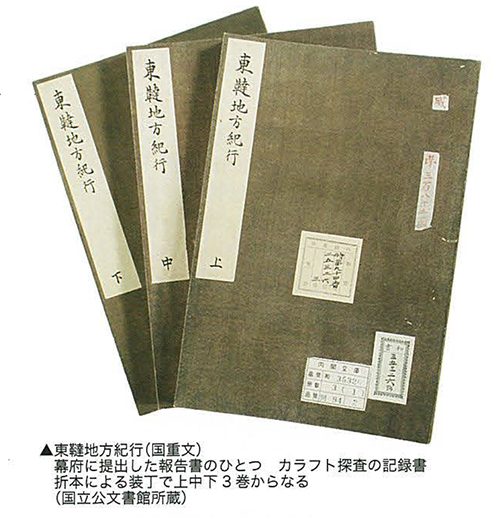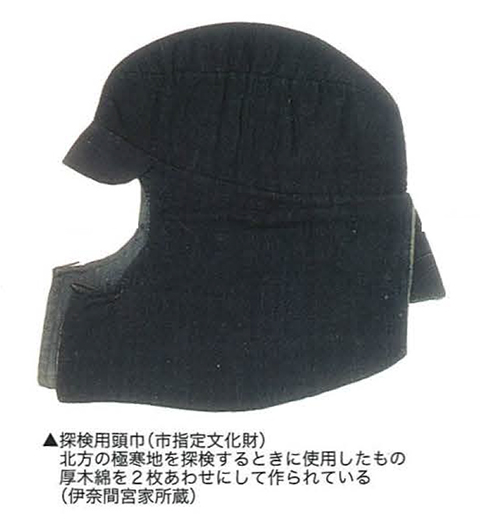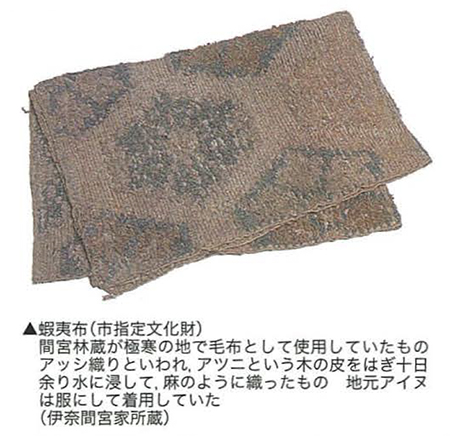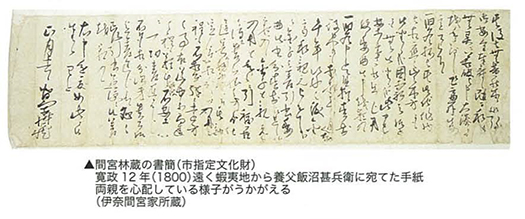


幕末期以降に北海道に寄せられた日本国家・国民からの熱視線はすさまじいものだった。相次いだ列強諸国からの開国・侵略圧力の中で、日本社会は明治以降の開拓のための国民世論醸成を進めていたとも言える。いまに至っても北海道が一種「特別な地域」認識を持たれていることのルーツには、こういった心情の部分にあるのではないだろうか。いわば独立と国運を左右する寒冷気候との日本民族の戦い、その最前線的な。
間宮林蔵は「出世」を願ったとされるけれど、その出世とは沸騰する海外からの圧力に対して「国のために身を捧げたい」という内心からの発露だったと思える。
かれの北方探索の事跡は樺太の測量の成功と、その後のデレンでの対外接触によって一段落を迎えることになった。20歳からひたすら北方探索・測量に捧げた時間が32歳になった時点で「東韃地方紀行」「北夷分界餘話」「北蝦夷ヶ島地図」などが作成・報告書提出された。
写真は上梓された報告書。また、北方探索に当たってかれが愛用したとされる頭巾や毛布。いずれも温暖地・日本社会にとって異界ともいえる北海道・樺太・北東アジアの旅に欠かせない「防寒」グッズたち。単純に日本列島とは隔絶した寒帯気候に立ち向かった足跡が伝わってくる。
1811年、32歳になった段階で、これらの報告資料を幕府に提出して幕臣としての立場からの退職を願い出たとされている。・・・当時の「世論」のなかでかれの北方探索の功績を称える雰囲気は強かったに違いない。後に水戸藩主・徳川斉昭が自藩での北海道開発を構想したとき、その情報の第一人者である間宮をいわば師範として招聘した事実が残っている。たぶんかれの事跡に対しての賛辞が世論として盛り上がっていたことが想像される。
一方でこうした国事への「奉公」に一段落付けたいという心情には父母の様子が気に掛かる、農家の一人っ子としての心情があったようにも思える。

この書簡はかれが国事に奔走するに当たって保証人・養父の立場として支援した隣村の有力者・飯沼甚兵衛に宛てて幕府奉公して6年後、任地蝦夷地から送ったもの。故郷に残った父母を心配する心情が書かれていると。かれの経歴を見るとこの翌年、23歳時点で一度「病気」で職を辞している。そしてその翌年には「病が癒えて」復職している。
想像だけれど、両親の健康と家の存続のことなどに悩んでその整理整頓を果たそうとしたのではないかと。故郷の「間宮家」には養子縁組がされ、かれ自身は江戸に本拠を移している。
・・・どうも間宮林蔵の事跡を辿ると熱が入ってしまう(笑)。本来は住宅がテーマのブログですが北海道人としてこの地に多くの人が住み始めた始原期のことが自然に知りたくなる。以前明治期の北海道開拓と寒冷地住宅事始めみたいなブログ探究をした経緯から、この間宮林蔵たちが活躍した先史部分にも、つい熱が入ってしまう次第です。ご容赦を。
English version⬇
Public Opinion and Love for Parents Boosted by Success of Northern Expedition – Rinzo Mamiya’s Birthplace – 9
The results of the Sakhalin expedition that reached Edo. The results of the survey that prevented Russian invasion. Amidst the outpouring of praise, Rinzo Mamiya’s heart yearns for the relatives he left behind in his hometown. …
Since the end of the Edo period, Hokkaido has been the focus of intense attention from the Japanese nation and its people. Amidst the pressure from a succession of powers to open the country to the outside world and invade, it can be said that Japanese society was fostering public opinion for the development of Hokkaido from the Meiji era onward. The fact that Hokkaido is still recognized as a “special region” may have its roots in this kind of sentiment. Hokkaido is the front line in the Japanese people’s battle against the cold climate, a battle that would determine the nation’s independence and national destiny.
Rinzo Mamiya is said to have wished to “rise in the world,” but it seems to me that his desire to rise in the world was an expression of his inner desire to “devote himself to the service of his country” in the face of the boiling pressure from abroad.
His exploration of the north came to an end with the successful survey of Sakhalin and his subsequent contact with the outside world in Deren, and at the age of 32, after devoting his entire time to exploring and surveying the north since the age of 20, he produced and submitted reports such as “Travels in the Eastern Lands,” “Hokiibunkai Buwa” and “Map of Northern Yezo Islands.
The photo shows the published reports. Also shown are the hoods and blankets he is said to have used during his exploration of the north. All of these “winter protection” goods were indispensable for his travels in Hokkaido, Sakhalin, and Northeast Asia, which were considered a different world from the warmer climate of Japanese society. They show the footprints of his efforts to confront the frigid climate, which was simply isolated from the Japanese archipelago.
It is said that in 1811, at the age of 32, he submitted these reported materials to the shogunate and asked for his retirement from his position as a shogunate retainer. …There must have been a strong atmosphere of admiration for his northern explorations in the “public opinion” of the time. Later, when Tokugawa Nariaki, the feudal lord of the Mito domain, conceived the idea of developing Hokkaido in his domain, he invited Mamiya, who was a leading authority on the subject, to serve as his mentor. It is likely that public opinion was in favor of Mamiya’s work.
On the other hand, it seems that Mamiya’s desire to settle down in his “service” to national affairs was also motivated by his concern for the condition of his parents as the only child of a farming family.
This letter was sent from Ezo to Iinuma Jinbei, an influential man from a neighboring village who supported him as a guarantor and foster father in his efforts to take care of national affairs, six years after he was appointed to the shogunate. The letter is said to express his concern for his parents who remained in his hometown. According to his biography, he resigned from his post the following year at the age of 23 due to an “illness. The following year, he “recovered from his illness” and returned to work.
I imagine that he was concerned about his parents’ health and the survival of the family, and tried to put things in order. He was adopted by the Mamiya family in his hometown, and he himself moved his home base to Edo.
I am very enthusiastic when I trace the history of Rinzo Mamiya (laugh). Although the theme of this blog is originally housing, as a person from Hokkaido, I naturally want to know about the early days when many people started to live in this area. I have previously written a blog about the development of Hokkaido in the Meiji period (1868-1912) and the beginning of cold-weather housing in Hokkaido, so I am also very passionate about the prehistoric period in which Rinzo Mamiya and his family were active. Please forgive me.
Posted on 5月 24th, 2023 by 三木 奎吾
Filed under: 歴史探訪







コメントを投稿
「※誹謗中傷や、悪意のある書き込み、営利目的などのコメントを防ぐために、投稿された全てのコメントは一時的に保留されますのでご了承ください。」
You must be logged in to post a comment.